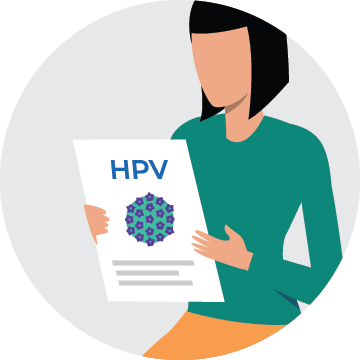HPV screening and follow-up pathway
Collecting samples for HPV primary screening
As jurisdictions implement HPV primary screening, they will need to determine whether to implement clinician-collected sampling and/or participant self-sampling (see Table 1). In research settings, both self-collected samples and physician-collected samples have been proven to be high quality, accurate methods of collection that performed similarly in detecting HPV.1
Self-sampling can be done in the privacy of one’s home or at a clinician’s office, and is an effective option available with an HPV primary screening approach. It will be important for jurisdictions to carefully consider their population’s needs as well as available follow-up resources (e.g., linking to primary care, colposcopy) to determine the most appropriate method of sample collection. A multi-pronged approach can also be considered to ensure increased access.
Table 1: Clinician-collected sampling and self-collected sampling
Clinician-collected sampling
+ Presents the opportunity to collect samples for both HPV and cytology testing at one time
– Barriers to access may be present for people living in rural/remote regions, people with a history of trauma and Indigenous populations2
– Uses more healthcare resources
Self-collected sampling
+ May improve participation among individuals who experience barriers to cervical screening via clinician-collected sampling.
– Samples can be used only for HPV testing. Follow-up of HPV-positive results requires linking to a care provider, which may be a barrier for those without a primary care provider or who do not feel comfortable having an exam.
Considerations for implementing clinician-collected sampling
 Recommendation: Develop culturally safe and trauma-informed processes and environments to support primary care providers to offer culturally safe and appropriate HPV primary screening sample collection.
Recommendation: Develop culturally safe and trauma-informed processes and environments to support primary care providers to offer culturally safe and appropriate HPV primary screening sample collection.
Key evidence and implementation considerations:
- Delivering culturally safe care requires providers to practice cultural safety and humility supported by safe physical spaces and processes. Cultural competency training is recommended for all providers and staff who interact with individuals accessing screening.
- Community champions or representatives from equity-deserving populations should be included in the development of this approach to ensure it is appropriate and acceptable to the intended community.
- Clinicians should be trained on approaches to addressing and supporting the provision of trauma-informed care. Participants with previous traumas may have concerns and anxieties about partaking in cervical cancer screening.
 Recommendation: Support primary care providers to educate their patients on the procedure for HPV primary screening.
Recommendation: Support primary care providers to educate their patients on the procedure for HPV primary screening.
Key evidence and implementation considerations:
- Primary care providers should be trained to educate their patients about clinician-collected sampling for HPV primary screening.
- Primary care providers should have access to participant screening history to tailor education and explain any differences the participant may expect if they have previously participated in Pap testing for cervical screening.
- In jurisdictions where HPV self-sampling is also an option, clinicians and/or cancer programs should discuss both options with participants to identify their preferences.
Considerations for implementing HPV self-sampling
 Recommendation: Support primary care providers to effectively communicate the benefits, safety, effectiveness, and process for self-sampling to their patients.
Recommendation: Support primary care providers to effectively communicate the benefits, safety, effectiveness, and process for self-sampling to their patients.
Key evidence and implementation considerations:
- Clinicians should be equipped to support personalized conversations around self-sampling to address individual concerns and questions, and to help participants feel more comfortable and confident in the process.
- Provide information on how self-sampling was not possible through Pap primary screening but is a new opportunity that is possible through the implementation of HPV primary screening.
- Clarify what participants can expect by participating in self-sampling, including how they will receive the test, how to complete it (including any mailing information that might apply), when to expect results and what they could mean, and possible next steps.
- It is especially important to address what can be expected should participants receive a positive HPV result.
- Resources should be made available to participants before they take part in self-sampling for HPV primary screening. Where possible, this should include a primary contact to answer any questions about the process or an individual’s test results. This is especially important when self-sampling is done at home.
- In under- and never-screened populations, providing additional tailored supports can improve participation. For example, Australia gave healthcare workers additional time to engage participants, explain the screening process and follow-up with them. They also offered transportation accommodations to meet the needs of some participants.3
 Recommendation: Develop and offer content in a variety of formats to explain what self-sampling is and how to do it, and to increase confidence in self-sampling and its acceptability.
Recommendation: Develop and offer content in a variety of formats to explain what self-sampling is and how to do it, and to increase confidence in self-sampling and its acceptability.
Key evidence and implementation considerations:
- Educational content can be offered to participants through online resources, brochures, pamphlets, videos and easy-to-follow instructions with diagrams. Using social media and QR codes will further engage younger populations. For example, QR codes linking to instructional videos could be included on self-sampling kits.
- Consider having peer-educators or community champions available to support individuals who have questions, concerns or misgivings about self-sampling. This has been found to promote acceptability in these groups.1
- To make these positions sustainable, jurisdictions should consider making them paid or offering other incentives to peer-educators and community champions.
 Key takeaway: Benefits of self-sampling
Key takeaway: Benefits of self-sampling
Self-sampling can be extremely helpful in several scenarios, such as the COVID-19 pandemic. It allows for physical distancing during screening and offers a way to provide important health services while many other services have been paused.1 Self-sampling also has the potential to be an effective and efficient way to continue screening while following public health pandemic-related guidelines.
This approach to screening can also be implemented in other situations where face-to-face interactions or access to a provider is not easily possible (i.e., during natural disasters, for rural and remote jurisdictions, and in primary care provider crises).
Recommendation: Consider a multi-pronged approach to distribute self-sampling kits.
Key evidence and implementation considerations:
- Where possible, provide participants with flexibility on where and how they obtain their sampling kits according to their needs, and ensure this process is accessible to different communities.1 Options include mailing kits and making kits available at community centres, friendship centres and clinicians’ offices.
- As they plan for kit distributions, jurisdictions can learn from the experiences of international programs. For example, Australia’s self-sampling happens in a clinical setting and is focused on under-screened populations, while the Netherlands mails kits to a person’s home if requested.3
- If kits are mailed to participants, infrastructure is needed to access and maintain address information. IT systems can enable jurisdictions to track changes in address and ensure appropriate mail-out according to eligibility.3 Additionally, jurisdictions should ensure kits are discreetly packaged to protect privacy and reduce stigma.1 Participants should have the option to submit completed self-collection tests to their healthcare provider.
Recommendation: Consider the acceptability of self-sampling and user experience with self-collection devices.
Key evidence and implementation considerations:
- Evidence shows that self-sampling has high acceptability rates among participants, especially when they have had at-home visits with healthcare workers.1,4 Engaging with communities will be important to understanding the acceptability of self-collection devices, and will also provide care providers with opportunities to address participants’ concerns around self-sampling.
- Individual concerns about self-sampling often relate to the reliability of the test and confidence that they are collecting a sample correctly.5 These concerns should be addressed by healthcare providers in communications with participants.
- It is important to consider physical limitations that can affect a person’s confidence and ability to self-sample.1For example, some types of sampling packaging, such as screw-top vials for sample delivery, can be difficult for individuals with physical mobility limitations.1
Recommendation: User instructions and educational materials should be included with a self-sampling kit, as well as made available online or on other platforms.
Key evidence and implementation considerations:
- Evidence has shown that two-minutes of step-by-step verbal instructions, followed by supporting videos, communications, and illustrations, are sufficient in explaining to participants how to collect, store and return a self-collected sample.3,4
- User instructions and educational materials should be brief, use plain language and include step-by-step instructions on how to use the self-sampling kit, including how to handle the specimen, how to store and submit it, and how participants will get their results.
- Instructions and materials should be visual-heavy and text-light.
- Where possible, kits should be personalized (e.g., with the laboratory requisition form pre-populated and device labelled) to simplify sample submission and minimize sample rejection due to labelling errors.
- Kits should be developed to match participants’ needs, including language, literacy levels and cultural requirements.
- Information intended to support informed decision-making when self-sampling should be included in the kits, especially for direct mailing approaches.
Recommendation: Clearly explain to participants their options for returning specimens for lab processing.
Key evidence and implementation considerations:
- Options for returning specimens can include pre-paid postage, dropping off directly at a lab or dropping off at another designated location (e.g., provider clinic or friendship centre).3
- Kits should provide return postage to enable easy return of specimens and increase participation.1
- Clark M, Horton J. Self-sampling devices for HPV testing. Canadian Journal of Health Technologies. 2021; 1(12). https ://doi.org/10.51731/cjht.2021.229
- Access Alliance. Critical discussion report: Reducing inequities in cervical cancer screening among newcomer women via HPV self-sampling. 2022.
- Canadian Partnership Against Cancer. HPV primary screening and abnormal screen follow-up for cervical cancer environmental scan. 2021. Accessed January 19, 2022. Available from: https://www.partnershipagainstcancer.ca/topics/hpv-primary-screening-environmental-scan/
- Pantano N, Fregnani J, Resende, J, et al. Evaluation of human papillomavirus self-collection offered by community health workers at home visits among under-screened women in Brazil. Journal of Medical Screening. 2020; 28(2):163-168. Doi:10.1177/0969141320941056
- Sultana F, Mullins R, English DR, et al. Women’s experience with home-based self-sampling for human papillomavirus testing. BMC Cancer. 2015; 15(1). https://doi.org/10.1186/s12885-015-1804-x
